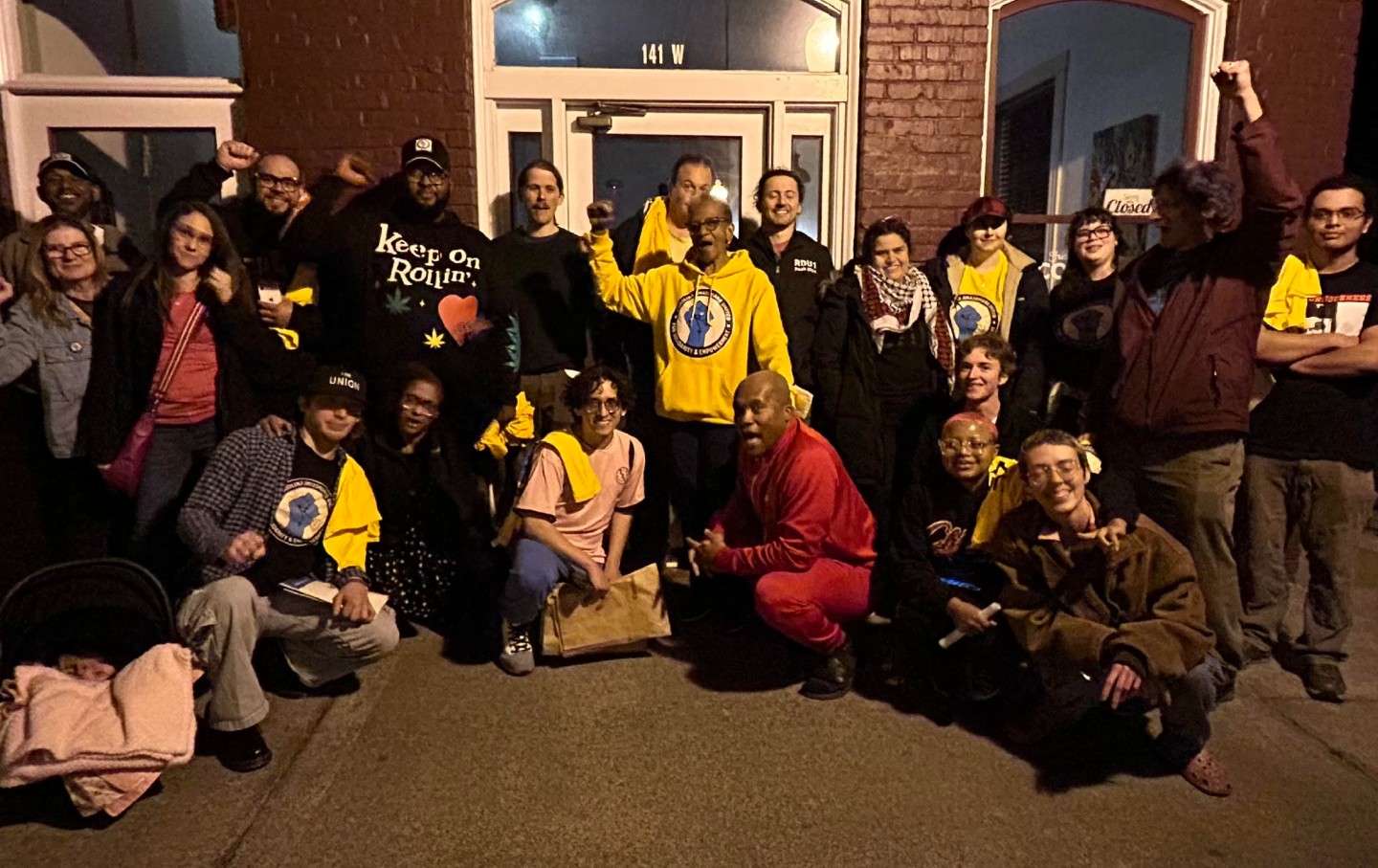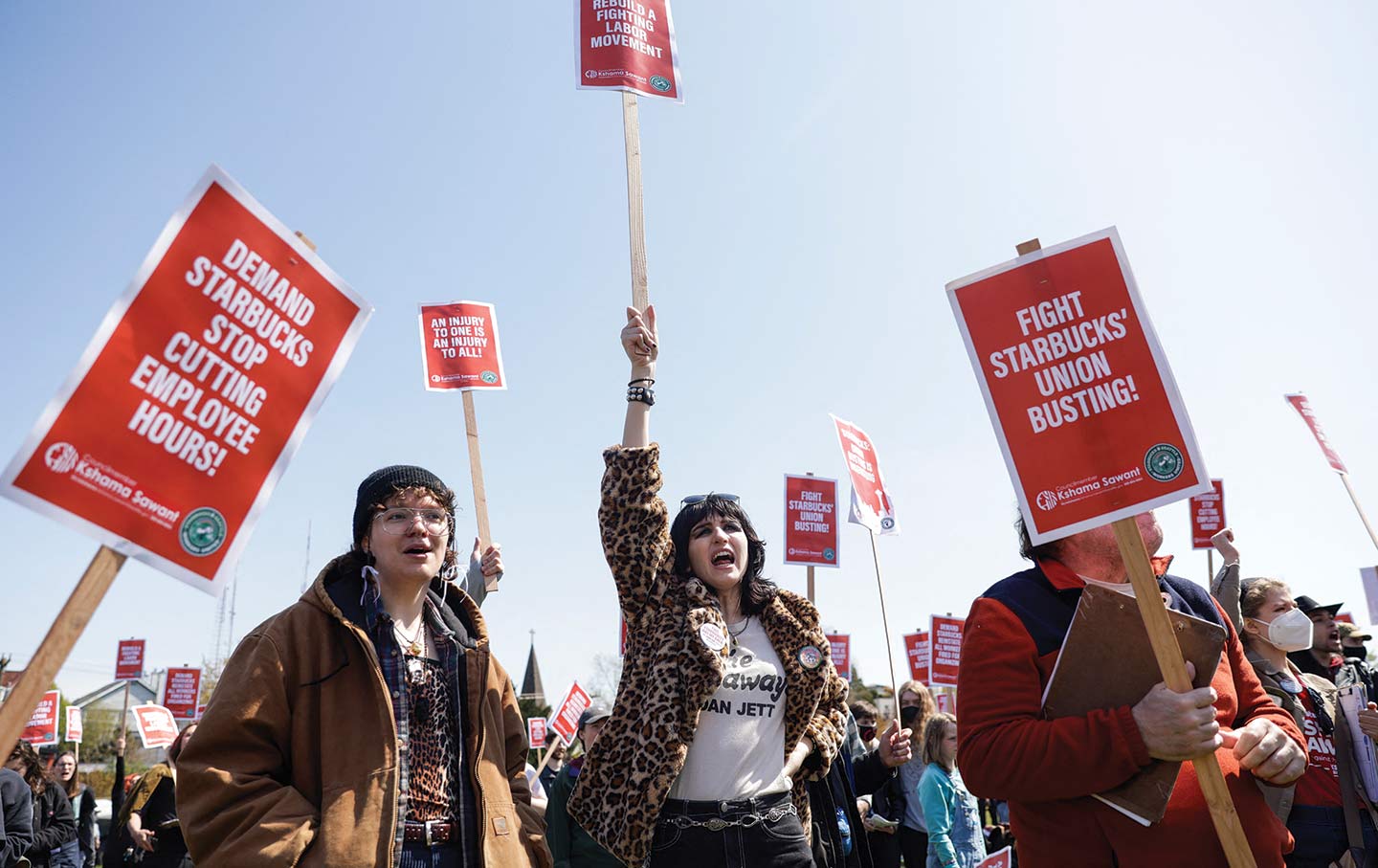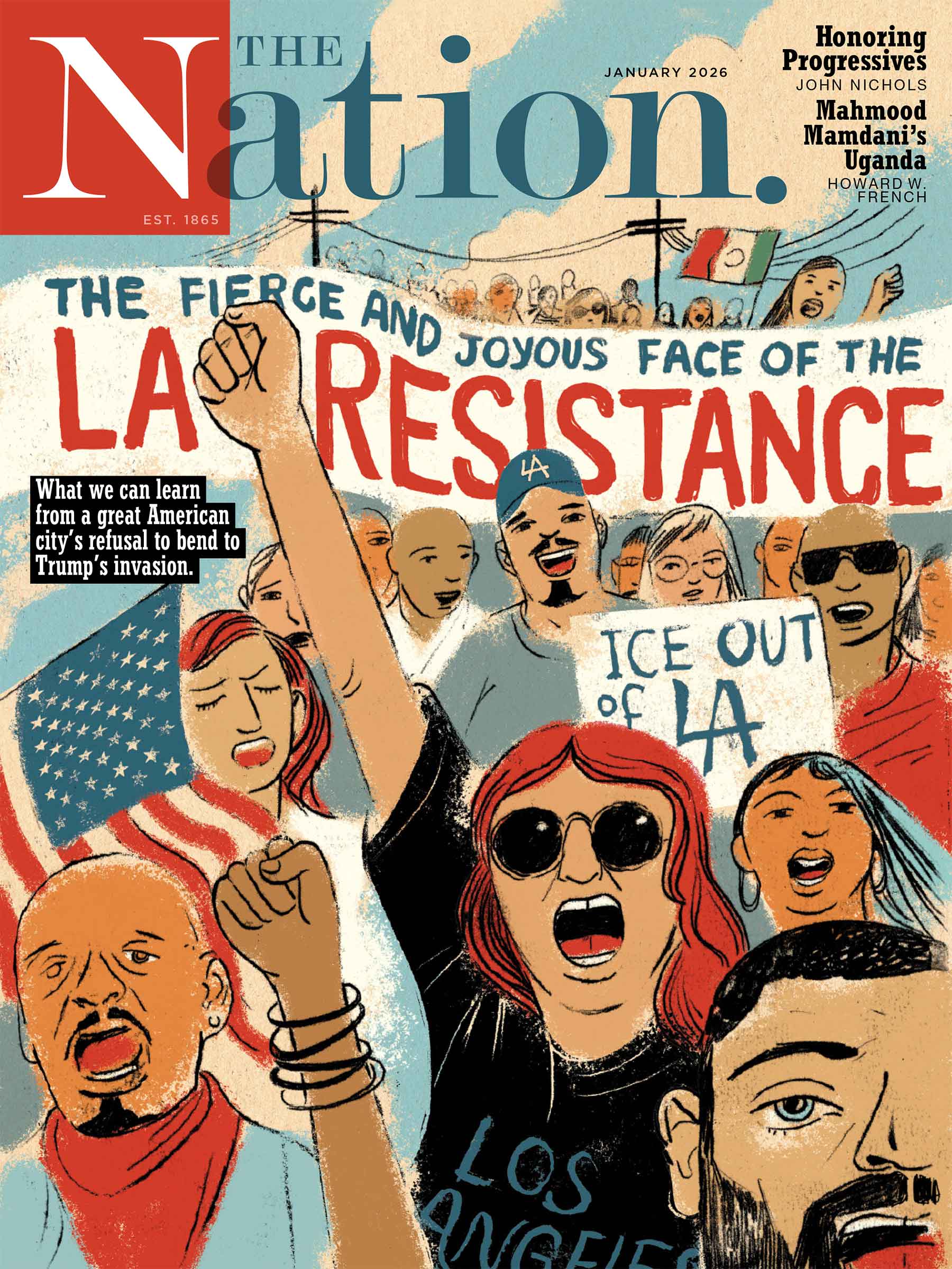After a North Carolina Election Loss, Amazon Union Organizers Must Think Bigger, Bolder
Local organizers built a multiracial, multigenerational union with grassroots energy and tenacity. But Amazon is too big to beat through site-by-site organizing and striking.

(Courtesy of Jonathan Rosenblum)
Garner, NC—The result in the end was disappointing, but not surprising.
By an overwhelming 2,447 to 829, Amazon workers at the massive RDU1 warehouse here rejected union representation in six days of balloting last week.
The campaign pitted the independent union CAUSE—Carolina Amazonians United for Solidarity and Empowerment—against the second-largest private employer in the US.
To label this a David-versus-Goliath fight would be an understatement. CAUSE is a homegrown union, started by RDU1 workers three years ago around core demands including a $30-an-hour starting wage, more paid time off, reasonable lunch breaks, and safety. The CAUSE members scrabbled together a bare-bones campaign budget with online fundraising campaigns and small grants. They built the fight with their own unpaid time and community volunteers.
Amazon, implacably hostile to worker power, brought its full arsenal of union busting to RDU1. After the union filed for an election last December, Amazon began staging around-the-clock anti-union meetings—brainwashing sessions, in which company lawyers and managers threatened workers with loss of their already-meager benefits, characterized bargaining as a futile process, and engaged in character assassination of CAUSE leaders. Amazon played the race and xenophobia cards to split the workforce: Managers told Latino workers that the union was just for Black workers, and they cynically highlighted the Trump deportation machine to further intimidate immigrant workers, who constitute a quarter or more of the RDU1 workforce.
Managers roamed the warehouse floor and singled out union supporters for harassment. In break rooms, CAUSE organizers reported, the company played “Vote No” videos on a continuous loop. They posted huge “Vote No” banners throughout the workplace. Anti-union literature was plastered everywhere, even in the bathroom stalls, while pro-union literature was promptly taken down. In the week leading up to the vote, Amazon erected fencing around the warehouse, posted security guards, and even arrested an Amazon worker—a union leader from the JFK8 facility in Staten Island, New York, who had come down to North Carolina to campaign with CAUSE.
For the last two months, RDU1 has been a zone of class warfare, albeit extremely lopsided.
It did not help matters that CAUSE fell short in several areas of organizing fundamentals. I spent several days in late January working directly with the CAUSE organizers in Garner, and among allies they were quite forthcoming about these shortcomings. The union filed its election petition above the requisite 30 percent threshold for union card sign-up, but well below the supermajority needed to endure the union-busting war.
In an environment where narrative control is decisive, CAUSE organizers recognized that they had allowed workplace discussions to drift away from the workers’ core demands. They spent considerable time responding to the boss’s latest lies and misrepresentations and focused a lot on legalistic processes as opposed to framing the fight about power and control. Crucially, I saw that, in the face of this withering anti-union campaign, the union had not been able to sustain a broad enough structure inside RDU1—organizing committee members, each with their own discrete group of workers they were responsible for—to weather the bosses’ firestorm. That is a main reason CAUSE organizers opted to not conduct a “structure test”—like a warehouse-wide “vote yes” petition—in the run-up to the balloting. Such a structure test would have assessed their true support and locked in “yes” votes.
All of these are shortcomings, to be sure, but while working alongside CAUSE I saw a creative, multiracial union led by Black and Latino workers, a vibrant organization steeped in democracy and fighting spirit. At a late-January union town hall, more than 60 RDU1 workers gathered in downtown Garner to discuss and debate issues. The union was founded by the Rev. Ryan Brown, a Baptist minister and an RDU1 worker until Amazon fired him last December, and Mary Hill, a feisty 70-year-old former truck driver who has spent the last year battling both Amazon and cancer. On display in the room that night was an eclectic mix including older African American church devotees, queer youth, socialist activists, middle-aged white workers, and immigrants from different Latin American countries. After three years of diligent organizing in a right-to-work state, under punishing circumstances, “Rev Ryan” and “Ma Mary,” as they are affectionately called by workers throughout RDU1, built a remarkable coalition.
At a time when many union leaders are hunkering down and even cozying up to corporate America and Trump by showcasing their own xenophobia, the CAUSE workers had the guts to meet Amazon in open combat, fighting for all workers regardless of country of origin.
Some labor organizers will argue that the CAUSE election loss shows the futility of elections. They could note that Amazon workers at the JFK8 warehouse won their union representation election nearly three years ago—and still remain stymied from bargaining by Amazon’s endless court appeals. Indeed, the International Brotherhood of Teamsters, the largest logistics workers’ union in the country, with campaigns at numerous Amazon worksites, has avoided representation elections at Amazon precisely because there is nothing free and fair about them in today’s America.
But election avoidance is shallow analysis. There is no question that a union representation election today entails running a hostile gauntlet. The election path should not be undertaken lightly. Yet the strategy of eschewing elections and pressuring the company through demonstration strikes involving a minority of workers—as the Teamsters have done in New York, the Bay Area, Southern California, Chicago, and Atlanta—also hasn’t moved the company any closer toward union recognition. However, the Teamsters’ lack of success to date doesn’t invalidate the importance of striking; nor does the CAUSE election result discredit voting strategies. Elections can be an effective strategy, so long as they are undertaken with rigorous organizing method—including strong, broad, tested organizing committees—and are seen not as an end goal but as a structure test on an escalating pathway toward powerful, majority-participation strikes.
But the central challenge facing today’s labor movement isn’t the elections-or-not conundrum. It is multiplying the scale of organizing by orders of magnitude.
With 1,445 warehouses, delivery stations, and air cargo centers and 1.7 million direct employees and contractors nationwide, Amazon is simply too large to beat through site-by-site organizing and striking. Given today’s political landscape and Amazon’s anti-union track record, it’s safe to say that a CAUSE election win last week would not have resulted in bargaining.
Popular
“swipe left below to view more authors”Swipe →To build enough worker power to compel Amazon to bargain, organizing will need to happen at dozens if not hundreds of worksites simultaneously, escalating to majority strike actions on a scale that can truly disrupt the company’s operations.
That will require organizing investments on the scale of hundreds of millions of dollars annually. The combined Amazon organizing investment today by unions—largely the Teamsters—is just over $10 million annually. That is barely a start. What’s needed is annual organizing commitments to fund thousands of organizers—both inside and outside Amazon facilities—along with a robust campaign infrastructure to build a new CIO-style industrial organizing movement.
That is eminently possible. Today, US labor movement assets top $35 billion—a 225 percent increase over the last 15 years, according to union researcher Chris Bohner. Collectively, the labor movement has sufficient resources to take on Amazon and win. But financing an industrial organizing campaign at Amazon requires a political decision by labor leaders—and the political will to follow through. Given the dire and declining state of labor and the central role of Amazon in the economy, what on earth are labor leaders waiting for?
In December, the Teamsters led demonstration strikes at eight Amazon facilities. These were all minority strikes—only about 600 workers in total participated—but the actions themselves built worker confidence and sparked organizing conversations among workers in warehouses far away from the strike lines. The demonstration strikes represented both a positive step forward and a learning experience. Likewise, the CAUSE members and those around them, though not victorious in this round, led a principled fight and gained organizing chops.
In the longer arc of labor’s existential struggle to organize at Amazon, the CAUSE election stands as another battleground where overmatched workers valiantly fought back. One hopes that CAUSE organizers will, in the wake of this lopsided defeat, draw lessons about the need to have a disciplined, tested, and broad union structure before plunging into battle again. Equally, one hopes that organizers looking from the outside will resist glib criticism of the CAUSE election, and instead seek to learn what CAUSE did right in building a multiracial, multigenerational union with sheer grassroots energy, chutzpah, and tenacity.
Labor’s challenge is to imagine what is possible when the rank-and-file creativity of CAUSE workers and other Amazon workers around the country merges with the full resources of the US labor movement. That is a fight against Goliath that David might just be able to win.
Disobey authoritarians, support The Nation
Over the past year you’ve read Nation writers like Elie Mystal, Kaveh Akbar, John Nichols, Joan Walsh, Bryce Covert, Dave Zirin, Jeet Heer, Michael T. Klare, Katha Pollitt, Amy Littlefield, Gregg Gonsalves, and Sasha Abramsky take on the Trump family’s corruption, set the record straight about Robert F. Kennedy Jr.’s catastrophic Make America Healthy Again movement, survey the fallout and human cost of the DOGE wrecking ball, anticipate the Supreme Court’s dangerous antidemocratic rulings, and amplify successful tactics of resistance on the streets and in Congress.
We publish these stories because when members of our communities are being abducted, household debt is climbing, and AI data centers are causing water and electricity shortages, we have a duty as journalists to do all we can to inform the public.
In 2026, our aim is to do more than ever before—but we need your support to make that happen.
Through December 31, a generous donor will match all donations up to $75,000. That means that your contribution will be doubled, dollar for dollar. If we hit the full match, we’ll be starting 2026 with $150,000 to invest in the stories that impact real people’s lives—the kinds of stories that billionaire-owned, corporate-backed outlets aren’t covering.
With your support, our team will publish major stories that the president and his allies won’t want you to read. We’ll cover the emerging military-tech industrial complex and matters of war, peace, and surveillance, as well as the affordability crisis, hunger, housing, healthcare, the environment, attacks on reproductive rights, and much more. At the same time, we’ll imagine alternatives to Trumpian rule and uplift efforts to create a better world, here and now.
While your gift has twice the impact, I’m asking you to support The Nation with a donation today. You’ll empower the journalists, editors, and fact-checkers best equipped to hold this authoritarian administration to account.
I hope you won’t miss this moment—donate to The Nation today.
Onward,
Katrina vanden Heuvel
Editor and publisher, The Nation
More from The Nation

Organized Labor at a Crossroads Organized Labor at a Crossroads
How can unions adapt to a new landscape of work?

The WNBA Makes More Money Than Ever. What About the Players? The WNBA Makes More Money Than Ever. What About the Players?
WNBA players receive around 10 percent of league revenue, while the NBA gives 51 percent. With their bargaining agreement expiring in January, players want to share in the growth....

If Condé Nast Can Illegally Fire Me, No Union Worker Is Safe If Condé Nast Can Illegally Fire Me, No Union Worker Is Safe
The Trump administration is making employers think they can ignore their legal obligations and trample on the rights of workers.

Federal Whistleblowers Sound an Alarm Over Civil Rights at HUD Federal Whistleblowers Sound an Alarm Over Civil Rights at HUD
Two of the federal workers who filed an emergency complaint about the Department of Housing and Urban Development speak out about the Trump administration’s actions.

Trump Has Handed Coal Miners a “Death Sentence.” But They’re Not Going Without a Fight. Trump Has Handed Coal Miners a “Death Sentence.” But They’re Not Going Without a Fight.
After the government betrayed them by refusing to enforce a crucial workplace health rule, a group of coal miners traveled to DC to put Trump on notice.

“There Are No Illegal Strikes—Only Unsuccessful Ones”: A Conversation With Sara Nelson “There Are No Illegal Strikes—Only Unsuccessful Ones”: A Conversation With Sara Nelson
The international president of the Association of Flight Attendants explains how labor solidarity can “set the agenda and make things better.”


